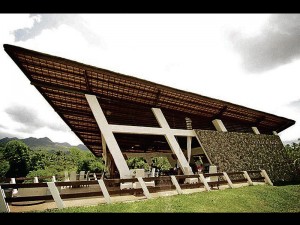
TRUE to the farm’s concept, Terrazas de Barako has a distinctly Filipino ambiance in a thatch-roofed terrace setting.
Inside the sprawling Hacienda San Benito in Lipa City, a restaurant serves organic cuisine that not only fills the stomach but also makes use of farm produce planted and raised by residents themselves.
Tucked away on the foothills of Mount Malarayat amid a backdrop of verdant landscape and a cascading pool is Terrazas de Barako, one of the farm estate’s prides, and touted to be the next organic cuisine destination in the country.
THE 230-SQUARE meter restaurant is perfect for small group meetings and people who would like to experience the “haciendero” lifestyle overlooking the farm and coffee plantation while gorging on healthy cuisine.
True to the farm’s reputation of being a residential and wellness community, Terrazas de Barako seeks to promote a food culture grounded on organic ingredients and homegrown livestock products.
In a recent tour to the expansive property owned by Milrose Development Corp, members of the press were able to interview Chef Teresa Lobb who is at the helm of the restaurant.
The British chef has more than 10 years of work experience cooking for some of Brunei Darussalam’s fine dining restaurants, and the British and Libyan royalties. She specializes in healthy and wellness cuisine.
The restaurant, located just a few meters from the main entrance, is open to the public but reservations must be made especially during peak seasons, according to Chef Teresa who herself is a lot owner in the 22-hectare hacienda.
ON TOP of hacienda living, owners can also make good investment from raising livestock or farming in their backyards.
Designed by Buensalido+Architects, the 230-square meter restaurant is perfect for small group meetings and people who would like to experience the “haciendero” lifestyle overlooking the farm and coffee plantation while gorging on healthy cuisine.
Terrazas de Barako also serves the world famous kapeng barako or the Philippine libereca and the delectable Maliputo fish from the Taal Lake.
“The promise of Terrazas de Barako is to stay as natural and organic as possible with ingredients locally produced and harvested from the hacienda. These are absolutely pesticide-free,” says Chef Teresa, who says she personally looks for ingredients inside the farm estate.
Menu options
Guests can enjoy a la carte or full course meals, or may request for a particular dish but prior arrangements must be made, says Chef Teresa. A full course meal costs about P1,700 per head.
At a press preview, the chef came up with a menu featuring roasted pumpkin and carrot soup with homemade bread rolls, and garden salad. The main course was pan-seared Maliputo fish, a hit among Terraza’s guests. The rare fish was served on mashed ube. The dessert was malunggay-crusted kamias tart with homemade coconut ice cream.
The chef says her menu is mainly on Western dishes, but she also works with local ingredients. She finds new ways of cooking using local produce.
“I don’t like to copy,” she says, adding that she enjoys playing with ingredients in coming up with her “personalized” menu.
CHEF Teresa Lobb has more than 10 years of work experience cooking for some of Brunei Darussalam’s fine dining restaurants, and the British and Libyan royalties.
Filipino ambiance
In line with the farm’s concept, Terrazas de Barako has a distinctly Filipino ambiance in a thatch-roofed terrace setting. The dining area is small but spacious enough to cater to small group meetings and can hold as much as 100 people.
The restaurant is an eco-friendly structure with generous air flowing in and out of the small space thanks to wooden slat windows and its strategic location overlooking the farmlands. Across the restaurant is Capilla de Sagrado Corazon, a modern take to an open-air circular chapel.
Hacienda San Benito offers lots for investors and people who like to retire in this hacienda-type farm estate. Each lot has sizeable backyard for farming and tenants could also raise poultry, goats, even horses themselves, or have them under the care of hacienda farmers for a fee.
Ricky Ocampo, Milrose president, says prices of lots inside the hacienda are competitive with condo rates in Manila. Their target buyers are new couples, Overseas Filipino Workers and urbanites who want a good investment or a retreat home not too far away from the city.
Hacienda lot owners can boast of the farm’s large apiaries (bee yards), koi ponds, and a club house. There are also eco-trams to transport guests and lot owners who want to leisurely roam around the vicinity.
On top of hacienda living, owners can also make good investment from raising livestock or farming in their backyards. For those who do not have prior farm management experience, a cooperative will assist them in making the most out of their lands, thus ensuring productivity and profitability. As lot owners, everyone will automatically become members of the cooperative with shares depending on their lot sizes. The cooperative also offers tending services for the owners’ farm and livestock property.